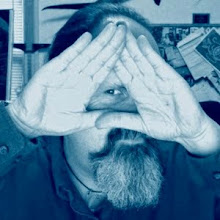While engaging in one of my increasingly favorite pastimes, perusing art on the Internet, I recently came across some interesting items:
Hieronymous Bosch action figures! More accurately, they would be described as “figurines”, but “action figures” just sounds cooler. (Technically speaking, action figures usually are “pose-able”, have moving parts, and do not stand on a base.)
These figurines are based on two of Bosch’s paintings, as seen below. (click to enlarge)
 The Garden of Earthly Delights
The Garden of Earthly Delights (center panel), ca. 1500
 The Last Judgement
The Last Judgement (center panel), ca. 1510
(From this point on, all text and images of figurines are from: http://www.3d-mouseion.com/engels/bosch_eng.htm)Hieronymus Bosch (1450-1516)From an artistic point of view, the world famous brilliant forerunner of surrealism was, in his day, unique and radically different. Hieronymus Bosch was born during the transition from the Middle Ages to the Renaissance in 's-Hertogenbosch, in the Duchy of Brabant [Netherlands]. Bosch places visionary images in a hostile world full of mysticism, with the conviction that the human being, due to its own stupidity and sinfulness has become prey to the devil himself. He holds a mirror to the world with his cerebral irony and magical symbolism, sparing no one. He aims his mocking arrows equally well at the hypocrisy of the clergy as the extravagance of the nobility and the immorality of the people. Hieronymus Bosch’s style arises from the tradition of the book illuminations (manuscript illustrations from the Middle Ages). The caricatural representation of evil tones down its terrifying implications, but also serves as a defiant warning with a theological basis.
 Helmeted Bird Monster
Helmeted Bird Monster (from
The Garden Of Earthly Delights)
This helmeted bird monster is carrying a pencil box and an inkpot in its beak, in which the nun, decaying into a pig, is dipping her pen. A severed foot is swinging from the bird's helmet referring to the horrible corporal punishments which could be expected in hell. The pig, indeed an indictment against the decay of clergy life, is tempting the man who is sitting beside him and it appears that he is drawing up a contract. Is the man possibly selling his soul?
 Devil On Night-Chair
Devil On Night-Chair (from
The Garden Of Earthly Delights)
It is presumed that somehow Bosch had knowledge of the Visio Tungdali, a twelfth century handwriting that describes a vision of a journey through hell. This was possibly the basis for this devil, crowned with a cauldron, symbolising the diabolical inferno fire. He is sat on a night chair, which offers him the possibility of excreting the gorged souls. His curious footwear in the shape of pitchers symbolises dipsomania. (original art below)

 Tree Man
Tree Man (from
The Garden Of Earthly Delights)
Many recognise a self-portrait in one of Bosch's most famous hybrid creatures. The hollow space in the egg-shaped body offers space for a pub. All breaks adrift through the two boats in which the tree-shaped paws are situated. Music and dance may have lead to licentiousness, symbolised by the bagpipes on the headwear. (original art below)

 Ears With Knife
Ears With Knife (from
The Garden Of Earthly Delights)
Two enormous ears, held together by an arrow and a knife jammed in between. Is there an allegorical medieval symbolism behind this, or are the horrible tortures one might expect in hell pictured here once more? Is the monogram on the knife an M of the B of Bosch? Maybe we will never know what Bosch ‘had between his ears’ when he was painting this picture.
 The Witches’ Kitchen
The Witches’ Kitchen (from
The Last Judgment)
On the left of the central panel of the triptych ‘The Last Judgement’ is a diabolic tavern. People are being cooked, smoked, put through mincing machines, squeezed, fried and roasted on the spit. In this witches’ kitchen, sinners are subjected to the ‘Judicium Extremum’ of the Supreme Judge. The punishment reflects the nature of the sins committed, in this case indulgence and gluttony.
 Blue Flutist
Blue Flutist (from
The Last Judgment)On the left hand side on the middle panel of the triptych The last Judgement a cheerful blue creature adds lustre with his music to the horrifying spectacle. He symbolises the lawlessness, ending in many not being admitted to heaven on Judgement Day.
 Freak with Beard
Freak with Beard (from
The Last Judgement)
The middle panel of the triptych
The Last Judgement shows a 'rillo' with beard, a freak with merely a head and legs. Furthermore, this creature has been adorned by Bosch with the tail of a reptile. He looks with a frightened expression at the mincer, where sinners are put through on Judgment Day.
 Headfooter
Headfooter (from
The Last Judgment)
On the foreground of the shocking central panel stands a creature characteristic of Bosch's work, consisting of only one head on two feet. His anatomical imperfections are covered by a headscarf. The painter has embroidered upon a classical Greek form in his own distinctive way. In ancient times, omitting body parts was also considered frightening. The character, amusing to us, seems to be taking a carefree stroll through the bloody scene of the Last Judgement.
To see more of Bosch’s paintings,
click here.







































